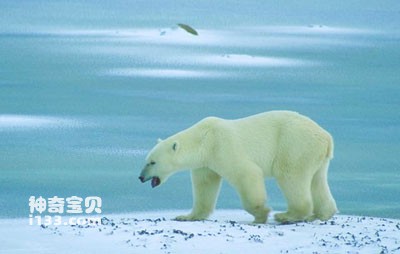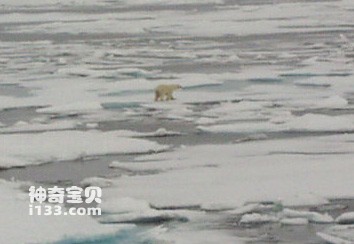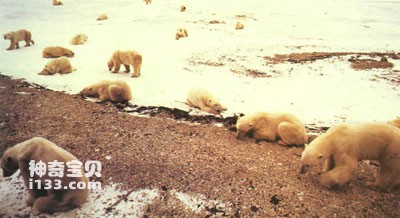The polar bear is the largest carnivore in the Arctic, and therefore the natural master of the Arctic. Just as the penguin is the symbol of the Antarctic, the representative of the North Pole is the polar bear.
From the perspective of ecological balance, if a giant polar bear wanders around on the grassland, it will not only pose a huge threat to the survival of the already small number of reindeer and musk oxen, but will also compete with wolves for food. , causing the wolves to fall into a state of hunger. Perhaps it is the Creator's thoughtful and ingenious arrangement, or perhaps it is the fact that polar bears disdain the company of wolves. The center of polar bear life is on the ice cap. Because there are a large number of walruses and seals thriving there, and except for a very small number of killer whales, there are basically no natural enemies. Their huge and fat bodies must be consumed by a powerful and gluttonous animal. Polar bears have just found their use. As a result, the polar bear established its undisputed dominance in this boundless world of ice and snow, and became the master of this white kingdom. It no longer has to go to land to compete with the poor wolves for food. Despite this, the polar bear is still a terrestrial animal.

Polar bears are one of the largest beasts on land today. They are distributed in the Arctic Ocean and other islands, as well as on the adjacent coasts of the Asian and American continents. In the Arctic, polar bears are found all year round. However, it is rarely seen in severe winter because they have a special habit - hibernation. They can go without food for a considerable period of time and their breathing rate is extremely low. But unlike the hibernation of ordinary organisms, it does not sleep with its head in the arms, but seems to be awake but not awake. It can wake up immediately when encountering an emergency, so its hibernation is called partial hibernation or hibernation.
Recent research also shows that polar bears can not only hibernate, but also aestivate. Canadian animal experts once captured several polar bears in the Hudson Bay in the fall. They found that the bear paws were covered with long hairs, indicating that they had not been active for a long time and had spent this time in aestivation. period of time.

Polar bear jumping among ice floes
Polar bears are covered with thick white fur, even their ears and paws, except for the tip of their nose, which is a little black. Moreover, the structure of its hair is extremely complex and hollow inside, which plays an excellent role in thermal insulation. Therefore, polar bears can walk easily on ice floes without worrying about the severe cold in the Arctic. The polar bear has a streamlined body shape and is good at swimming. The bear's paws are as wide as a scull. Therefore, in the cold water of the Arctic Ocean, it can use its two front legs to row forward, and its hind legs are together to control the direction of progress and play a role. With the function of the rudder, it can swim forty or fifty kilometers in one breath. The polar bear's claws are like iron hooks, and its teeth are extremely sharp. With a swipe of its front paw, it can smash a person's head to pieces, leaving the body intact. The polar bear runs at lightning speed, reaching speeds of up to 60 kilometers per hour, but it cannot last long and only sprints for short distances. So if you are attacked by a polar bear in the Arctic, you can discuss with it a long-distance running race, in which case the polar bear will definitely lose.
Polar bears are carnivores and their staple food is seals. Every spring and early summer, groups of seals lie on the ice to bask in the sun. Polar bears will carefully observe their prey, and then cleverly use the geographical situation to approach the seals step by step. When they are within the effective fishing range, they will Like an arrow off the string, it rushed over. Although the seal was always cautious, it was too late when it was discovered. The huge bear paw struck down with lightning speed, and its brains were immediately wiped out.
In winter, polar bears use amazing endurance to wait for seals at the breathing holes of the ice sheet for hours, concentrating and motionless, like snowdrifts, and covering their noses with their palms to prevent their own smell and breathing from destroying them. The seals were scared away. When the long-awaited seal shows its head, the polar bear that has been "waiting" for a long time will slap the seal on the head at a very fast speed. The poor seal has not yet figured out what happened, and it becomes confused. Splattered everywhere and died.
Polar bears also have a way to deal with seals lying on ice floes. It will use its swimming expertise to quietly approach the seal from the water, and sometimes it will push an ice floe for cover. After catching a seal, they will have a delicious meal and then go away. The polar bear is also smart in that if it encounters a seal while swimming, it will remain indifferent and seem to turn a blind eye. Because it knows very well that in the water, it is no match for the seal. Instead of fighting a desperate duel, which will end up in vain, it is better to let the seal go without consuming its own energy.

Polar bear discovered during China's first Arctic expedition
The polar bear's olfactory organ is extremely sensitive. It can smell the smell of burning seal fat from 3.2 kilometers away. In the spring of 1992, the Eskimos captured many whales, dumped their entrails in garbage pits around Barrow, and then buried them in the soil. After the sea freezes in autumn, polar bears come to the village here smelling the scent, and there are quite a lot of them. People's safety is seriously threatened, so people use various methods, such as roaring helicopters and firecrackers. , in an attempt to drive them away, but with little success. For those few polar bears who are so bold that they pose a serious threat to human life. It had to be shot. Sometimes, polar bears will secretly enter the camp of the Arctic Science Station and run into tents or kitchens and warehouses to rummage through boxes and cabinets in an attempt to taste human food; sometimes, polar bears are extremely docile and cute, and become very interested in the activities of people at the science station. , often following people or lying on the ice in the distance, watching people work.
For the Eskimos, polar bears are their most terrifying enemies. Before the introduction of guns, if they were attacked by a polar bear, they would most likely be killed by the bear. In order to prevent people from panicking when they encounter polar bears unexpectedly, here is a brief introduction to the characteristics of polar bears when they attack people. Generally speaking, aggressive polar bears often appear irritable and intermittently exhale from their nostrils. At this time, people should be careful and try to drive away the polar bear. The easiest way is to shout as loud as possible and keep shouting at them. It throws ice and stones, accompanied by the sound of banging iron tools. Don't run away when you see a bear. This is the stupidest move. It plays into the hands of the polar bear. It will catch up at a very fast speed, and a vicious "bear" will prey on you. Then with a bear's paw, your head will bloom. Therefore, when inspecting and working in areas where polar bears are found, it is best to carry a gun with you to avoid accidents. As for the polar bear that prances slowly, moves casually, stretches its head forward, sniffs here and there, and looks leisurely and contented, there is no need to make a fuss, because at this time, it does not mean any harm. Of course, it's always better to be careful when dealing with moody beasts.

Polar bears that are used to moving alone sometimes gather together.
Arctic spring (March and April) is the mating period for polar bears, which usually lasts about two weeks and sometimes lasts for up to a month. Sexually mature female polar bears (over 4 years old) and male polar bears (over 5 years old) may have come to meet each other due to fate, or may be caused by telepathy. After meeting, the two parties can walk together on the crystal clear ice cap. Of course, not all female bears are satisfied with male bears. In this case, male bears will often take violent actions, and the two parties will fight. But how can a weak female bear be a match for a large and sturdy male bear? In the end, the female bear was not only bruised and bruised, but also had to beg for mercy and had to become a bride against her will. In a sense, although what the male polar bear does is a bit rough, it is extremely beneficial to the reproduction of the entire species.
The indigenous people in the Arctic respect and worship polar bears very much, but they still hunt polar bears. It is said that in ancient times, the Eskimos had such a custom: after death, or those who were sick or disabled, they would be sent to the wilderness where polar bears often haunted, where they would sit upright and wait for the polar bears to eat them. Because they understand that as long as polar bears survive, their descendants will have polar bears to hunt and get enough food to survive. After the indigenous people in the Arctic capture a polar bear, they hold a grand ceremony. For example, the Eskimos in Alaska often perform the "Bear Dance" to celebrate catching polar bears; the Eskimos in Greenland, the mothers and wives of hunters wear shoes with "bear mane" trims to show respect and honor; the most special thing is What is surprising is that when the Siberian Eskimos dismember a polar bear, they first take out the heart, then cut it into pieces and throw it behind them to save the soul of the polar bear.

Looking up to the sky and screaming in sorrow
People hunt polar bears for their skin and meat. Polar bear meat is one of the most important food sources for the Eskimos. Bear skins are daily necessities for local residents. They are made of fur clothing, shoes and socks, which provide them with the best insulation and cold protection items.
In the Arctic region, the Eskimos only use bows, arrows and spears to capture polar bears. Their population is small and the number of polar bears captured is not large, so they do not pose a threat to the survival of polar bears. Driven by the desire for profit, bear hunting ships from other places came into being and regularly sailed into the Arctic waters to hunt and plunder, resulting in a sharp decrease in the number of polar bears. According to statistics, there are currently no more than 20,000 polar bears in the Arctic. On average, there is only one polar bear per 700 square kilometers of ice; and with the development of Arctic oil resources, advanced icebreakers, aircraft, submarines, etc. have entered the Arctic, and the survival of polar bears has been seriously threatened.
To this end, countries in the Arctic region signed international conventions to protect polar bears from 1973 to 1975. The Convention stipulates: Strictly control the sale and trafficking of natural bear skins and their products.
animal tags:
We created this article in conjunction with AI technology, then made sure it was fact-checked and edited by a Animals Top editor.